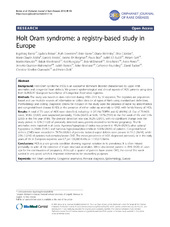| dc.contributor.author | Barisic, Ingeborg | en_US |
| dc.contributor.author | Boban, Ljubica | en_US |
| dc.contributor.author | Greenlees, Ruth | en_US |
| dc.contributor.author | Garne, Ester | en_US |
| dc.contributor.author | Wellesley, Diana | en_US |
| dc.contributor.author | Calzolari, Elisa | en_US |
| dc.contributor.author | Addor, Marie-Claude | en_US |
| dc.contributor.author | Arriola, Larraitz | en_US |
| dc.contributor.author | Bergman, Jorieke E. H. | en_US |
| dc.contributor.author | Braz, Paula | en_US |
| dc.contributor.author | Budd, Judith L. S. | en_US |
| dc.contributor.author | Gatt, Miriam | en_US |
| dc.contributor.author | Haeusler, Martin | en_US |
| dc.contributor.author | Khoshnood, Babak | en_US |
| dc.contributor.author | Klungsøyr, Kari | en_US |
| dc.contributor.author | McDonnell, Bob | en_US |
| dc.contributor.author | Nelen, Vera | en_US |
| dc.contributor.author | Pierini, Anna | en_US |
| dc.contributor.author | Queisser-Wahrendorf, Annette | en_US |
| dc.contributor.author | Rankin, Judith | en_US |
| dc.contributor.author | Rissmann, Anke | en_US |
| dc.contributor.author | Rounding, Catherine | en_US |
| dc.contributor.author | Tucker, David | en_US |
| dc.contributor.author | Verellen-Dumoulin, Christine | en_US |
| dc.contributor.author | Dolk, Helen | en_US |
| dc.date.accessioned | 2014-11-10T13:58:33Z | |
| dc.date.available | 2014-11-10T13:58:33Z | |
| dc.date.issued | 2014-10-25 | eng |
| dc.identifier.issn | 1750-1172 | |
| dc.identifier.uri | https://hdl.handle.net/1956/8730 | |
| dc.description.abstract | Background: Holt-Oram syndrome (HOS) is an autosomal dominant disorder characterised by upper limb anomalies and congenital heart defects. We present epidemiological and clinical aspects of HOS patients using data from EUROCAT (European Surveillance of Congenital Anomalies) registries. Methods: The study was based on data collected during 1990–2011 by 34 registries. The registries are populationbased and use multiple sources of information to collect data on all types of birth using standardized definitions, methodology and coding. Diagnostic criteria for inclusion in the study were the presence of radial ray abnormalities and congenital heart disease (CHD), or the presence of either radial ray anomaly or CHD, with family history of HOS. Results: A total of 73 cases of HOS were identified, including 11 (15.1%) TOPFA and 62 (84.9%) LB. Out of 73 HOS cases, 30.8% (20/65) were suspected prenatally, 55.4% (36/65) at birth, 10.7% (7/65) in the first week of life, and 3.1% (2/65) in the first year of life. The prenatal detection rate was 39.2% (20/51), with no significant change over the study period. In 55% (11/20) of prenatally detected cases, parents decided to terminate pregnancy. Thumb anomalies were reported in all cases. Agenesis/hypoplasia of radius was present in 49.2% (30/61), ulnar aplasia/ hypoplasia in 24.6% (15/61) and humerus hypoplasia/phocomelia in 42.6% (26/61) of patients. Congenital heart defects (CHD) were recorded in 78.7% (48/61) of patients. Isolated septal defects were present in 54.2 (26/48), while 25% (12/48) of patients had complex/severe CHD. The mean prevalence of HOS diagnosed prenatally or in the early years of life in European registries was 0.7 per 100,000 births or 1:135,615 births. Conclusions: HOS is a rare genetic condition showing regional variation in its prevalence. It is often missed prenatally, in spite of the existence of major structural anomalies. When discovered, parents in 45% (9/20) of cases opt for the continuation of pregnancy. Although a quarter of patients have severe CHD, the overall first week survival is very good, which is important information for counselling purposes. | en_US |
| dc.language.iso | eng | eng |
| dc.publisher | BioMed Central | eng |
| dc.rights | Attribution CC BY | eng |
| dc.rights.uri | http://creativecommons.org/licenses/by/4.0 | eng |
| dc.subject | Holt Oram syndrome | eng |
| dc.subject | Congenital anomalies | eng |
| dc.subject | Prenatal diagnosis | eng |
| dc.subject | Epidemiology | eng |
| dc.subject | Europe | eng |
| dc.title | Holt Oram syndrome: a registry-based study in Europe | en_US |
| dc.type | Peer reviewed | |
| dc.type | Journal article | |
| dc.date.updated | 2014-11-07T16:03:57Z | |
| dc.description.version | publishedVersion | en_US |
| dc.rights.holder | Copyright 2014 Barisic et al.; licensee BioMed Central Ltd | |
| dc.rights.holder | Ingeborg Barisic et al.; licensee BioMed Central Ltd. | |
| dc.source.articlenumber | 156 | |
| dc.identifier.doi | https://doi.org/10.1186/s13023-014-0156-y | |
| dc.source.journal | Orphanet Journal of Rare Diseases | |
| dc.source.40 | 9 | |

